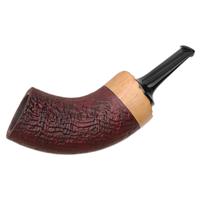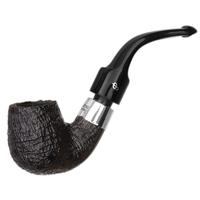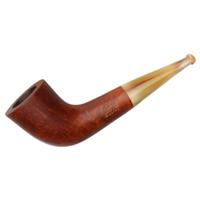yeah that's another thing notes aren't meant to be taken literally but more like the taste reminds me of the smell of fresh cut grass then it tastes like grass. It's stolen from wine notes basically. Which if you get that it changes your expectations. It intended to give a certain uniformity to descriptions.Don't listen to people that tell you it tastes like 'hay' or 'freshly cut grass' or 'a fresh loaf of bread' etc...no one, i'm sure, has ever smoked hay, grass or bread (and I grow hay for a living). Sweet is a relative term...if what you are smoking tastes sweeter than an untopped uncased burley, then its sweet, if it doesn't, it's not. 90% of what I smoke are pure or nearly pure virginias and they do tend to be relatively sweeter on average than other types of leaf...that's about the size of it...it's not rocket science.
Confused: What Does A Naturally Sweet Virgina Taste Like?
- Thread starter geopiper
- Start date
You are using an out of date browser. It may not display this or other websites correctly.
You should upgrade or use an alternative browser.
You should upgrade or use an alternative browser.
- Status
- Not open for further replies.
Don't listen to people that tell you it tastes like 'hay' or 'freshly cut grass' or 'a fresh loaf of bread' etc...no one, i'm sure, has ever smoked hay, grass or bread (and I grow hay for a living).
I don't imagine many people have smoked cherries either but that doesn't stop blenders from making cherry blends.
I held out an ounce or so from the last pound of Match Victorian I got in February 2020 fromPipes and Cigars, and smoked it in less than a week. I detected nothing approaching “chemical sweetness. “. But, like everything else these days, if it is on YouTube it must be the gospel truth.I have smoked the Murray's, and the Sutliff is awfully close. No idea who the YouTube guy is, but even Jim never mentioned an added flavoring.
What by the way is “chemical” sweetness versus “non chemical” sweetness?
Aspartame?What by the way is “chemical” sweetness versus “non chemical” sweetness?
As seen above, hay and grassy are often mentioned. I think it is the way hay smells (since as stated we don't eat it). It seems to me, if a Virginia comes up "sweet" without any non-tobacco flavoring, it is high quality, the sweeter the better. Disclaimer: I enjoy a good Virginia, but burley is my favorite.
Blenders often use the terms grassy, hay, bread and sweet in the descriptions of their own blends. I don't have a problem with it, even if I don't always taste exactly what they've described.
I've been a latakia guy for some time. I'm trying to develop my Virginia palate, but I've encountered quite a few highly recommended blends like PS Luxury Bullseye Flake and Escudo and I just don't care for them. I did try some Dan Tobacco Salty Dogs and loved it.
Anyway, I don't get the sweet descriptions people are using for Virginia. When I smell hay or grass, sweet doesn't come to mind, so I'm always left confused when I read descriptions of sweet aged Virginia and they talk about hay or grass.
I taste the sweetness in Salty Dogs, but that's more of a stewed or dried fruit sweetness to me, nothing I would associate with grass or hay.
Anyway, I don't get the sweet descriptions people are using for Virginia. When I smell hay or grass, sweet doesn't come to mind, so I'm always left confused when I read descriptions of sweet aged Virginia and they talk about hay or grass.
I taste the sweetness in Salty Dogs, but that's more of a stewed or dried fruit sweetness to me, nothing I would associate with grass or hay.
Same here I don’t get much sweetness from capstan .. a bit but it’s more bready and stewed fruits.That's funny I get bready flavors from Capstan more than sweetness. Have you tried Peretti RCTR by any chance? I find it crazy sweet, bizzarely sweet... like "someone pored a packet of Splenda on it" sweet.
It's not really what I'm looking for from a straight VA but someone must like it.
Same here I don’t get much sweetness from capstan .. a bit but it’s more bready and stewed fruits.
Yep. FVF is the sweet one.. at least that's my experience.
Exactly what it sounds like. I know the stuff I have has some sort of chemical applied to it because it doesn't dry out like normal tobacco does. It reminds me of the other PG laden blends that Sutliff applies to their aromatics. I don't know if smoking pipes has a mislabeled batch or what, but I've smoked alot of vapers and this has something unnatural added to it that others dont have.What by the way is “chemical” sweetness versus “non chemical” sweetness?
Last edited:
Newminster 400 tastes like a warm stream of Chianti tinged with cranberry juice.
This is not quite true, if by describing a blend as "uncased," we are referring to a blend that has not had any sweetener or other flavor augmenting casing applied. Technically preservative additives, which are applied in the same way, are casings as well, but these do not contain anything that contributes a detectable flavor to the tobacco, and therefore these types of preservative casings are, I think, not what most people are referring to when they talk about blends that are "cased" or "uncased". So if we can agree that, for the purposes of this discussion, casing refers to added sweetening agents or other additives intended to change the taste of a tobacco, then C&D makes a very large number of blends that contain no casing or toppings.Unless you grow it yourself, there's no such thing. All commercially available tobaccos are cased.
Most manufacturers, C&D included, will purchase a particular lot of tobacco that has been harvested, cured and either hand-stripped, machine stripped, or in whole intact leaf, and then those manufacturers apply casing to the leaf themselves, or have the processor that they purchased the leaf from case it for them at an additional cost. All of the tobaccos that we purchase come to us untopped, uncased, except for Black Cavendish, which is cased as part of it's process. None of our other tobaccos are cased before we receive them into our facility. In instances that we do use a casing, that casing is blend specific; Sometimes applied to the entire blend, sometimes applied to only one component in the blend prior to blending. We have only a handful of blends that are cased, many that are uncased and untopped and a few that are topped but not cased. For example Opening Night and Union Square are examples of truly untopped, uncased Red and Bright Virginia flake. Derringer, on the other hand, uses the same Red and Bright Virginia but a brown sugar casing is applied to the blend prior to pressing, yielding a different, but still very natural flavor profile, compared to Opening Night or Union Square. In every instance where casing is used in our process, the casing is designed specifically for one blend, and is not used on any other blend. I know of no other manufacturer that takes this approach with the level of granularity that C&D does.
Just going by a write up Greg Pease did on here a few years ago.This is not quite true
I think I recall the one you mean, from some time back, and I cannot speak to how Greg's conclusion was reached, or precisely what the context of the claim was without tracking it down. However, I can assure you, as the guy whose job it is to visit tobacco fields and warehouses, observing, sampling and selecting leaf from all over the world for use in all of the products that C&D produces, that leaf dealers do not case their leaf prior to selling it to a customer. Manufacturers of tobacco products are VERY specific, secretive and possessive of their casing recipes, and few (none that I know of) would want to buy tobacco that had been pre-cased with something other than their own formula. There are big companies that develop custom casing recipes for high volume manufacturers (some pipe tobacco tobacco, but mostly of cigarettes and chew) and these casings, as well as the research and development to make them, can be very costly. Most pipe tobacco manufacturers however, develop their own casings in house and guard these recipes doggedly, as they are the result of a LOT of creative thinking, experimentation and energy in development. A leaf dealer trying to sell tobacco that has already been cased has basically increased his costs, increased the price of the product and at the same time, dramatically narrowed his customer pool for that particular lot. This would be a difficult sale for most leaf dealers to make unless the formula and rate of application they used matched perfectly what a particular manufacturer was interested in, as well as the grade and style of the tobacco. Now as to whether the vast majority of pipe tobacco is manufactured with a casing some kind applied? Absolutely that is true. But C&D and GL Pease, as well as Chacom, Briarworks, Captain Earle's, Warped, and all of the brands that we manufacture represent a large number of blends where there is no sugar or sweetener casing or topping added. I hope this helps to clarify a bit more.Just going by a write up Greg Pease did on here a few years ago.
is this only necessary due to only using two different types of VA leaf?This is not quite true, if by describing a blend as "uncased," we are referring to a blend that has not had any sweetener or other flavor augmenting casing applied. Technically preservative additives, which are applied in the same way, are casings as well, but these do not contain anything that contributes a detectable flavor to the tobacco, and therefore these types of preservative casings are, I think, not what most people are referring to when they talk about blends that are "cased" or "uncased". So if we can agree that, for the purposes of this discussion, casing refers to added sweetening agents or other additives intended to change the taste of a tobacco, then C&D makes a very large number of blends that contain no casing or toppings.
Most manufacturers, C&D included, will purchase a particular lot of tobacco that has been harvested, cured and either hand-stripped, machine stripped, or in whole intact leaf, and then those manufacturers apply casing to the leaf themselves, or have the processor that they purchased the leaf from case it for them at an additional cost. All of the tobaccos that we purchase come to us untopped, uncased, except for Black Cavendish, which is cased as part of it's process. None of our other tobaccos are cased before we receive them into our facility. In instances that we do use a casing, that casing is blend specific; Sometimes applied to the entire blend, sometimes applied to only one component in the blend prior to blending. We have only a handful of blends that are cased, many that are uncased and untopped and a few that are topped but not cased. For example Opening Night and Union Square are examples of truly untopped, uncased Red and Bright Virginia flake. Derringer, on the other hand, uses the same Red and Bright Virginia but a brown sugar casing is applied to the blend prior to pressing, yielding a different, but still very natural flavor profile, compared to Opening Night or Union Square. In every instance where casing is used in our process, the casing is designed specifically for one blend, and is not used on any other blend. I know of no other manufacturer that takes this approach with the level of granularity that C&D does.
is this only necessary due to only using two different types of VA leaf?
We have a few different lots of Red Virginia leaf, for example the grade that is used in CRF and the 2003 grade that is used for Bijou, as well as one lot of Bright, and two different lots of Orange leaf for flue cured AKA Virginia, leaf. And then one lot each of White Burley, Dark Burley, Perique, Latakia, Basma, Izmir, Katerini, Dominican Cigar, Italian Cigar, US Black Cavendish, Dominican Cigar Cavendish, Dark Fire KY, Light Fire KY, and Kasturi. With these tobaccos, there is a lot of variation and nuance that can be accomplished just by careful blend development, without casing. Casing is just one of many arrows in our quiver, so to speak, and it's one we don't use but in a handful of blends, and one that we use sparingly. I hope that answers your question.
Jeremy, thanks for all the details about casing. Very informative.
I am happy to be of service, and offer my experience and provide information anytime!Jeremy, thanks for all the details about casing. Very informative.
- Status
- Not open for further replies.











